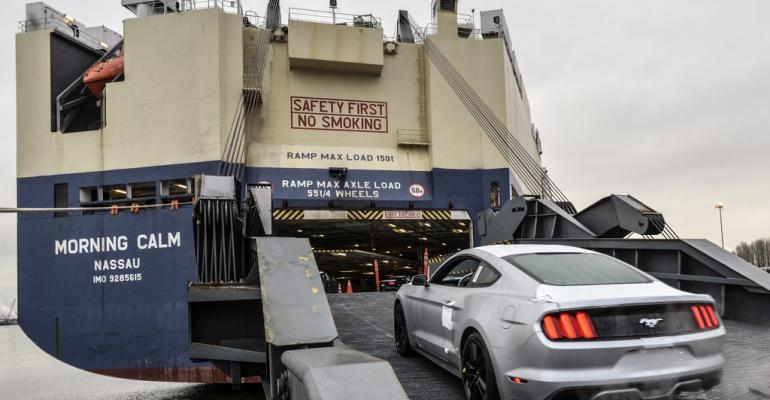A test of whether the planned European Union-U.S. Transatlantic Trade and Investment Partnership (TTIP) is a free-trade deal that creates real additional wealth will be how it treats the automotive sector, according to reviews of the agreement.
The EU and U.S. have widely divergent automotive regulatory systems and bringing them together will take political courage and imagination, the reports say. A deal would open each side’s manufacturers to new competition but also would foster collaboration and reduce regulatory tax costs, they conclude.
A June study by the U.S.-based Petersen Institute of International Economics contends harmonizing U.S.-EU regulations would boost auto trade at least 20%, gaining the partners more than $20 billion per year, combined, in the long term. A note on the report from ACEA, the European automakers’ group, claims this rise would represent at least 240,000 more vehicles traded annually across the Atlantic.
Given that the majority of global auto production, including the EU, U.S., Japan and South Korea, is governed by the United Nations’ 1958 Agreement on International Automotive Technical Regulation, the U.S. should use the TTIP to move toward that model.
But the Petersen report notes American regulation differs significantly from the EU’s system of proactive approval in that it is based on self-certification by manufacturers with spot checks. Shifting the U.S. system to that used in Europe would be very expensive.
The Petersen study suggests harmonizing EU and U.S. technical regulations where overlaps already exist, and mutually recognizing other regulations and approval methods. This would allow “firms to streamline production and offers increased variety for consumers without implicitly favoring either the existing EU or U.S. systems,” it says.
There should be no safety downside, argues Petersen, because EU and U.S. safety records closely match. Accident numbers vary largely by local income levels, with poorer regions having more road accidents, and not by contrasting safety regulations, the report says.
Agreement Could Be Global Trade Template
The report also recommends extending this liberal approach to other manufacturing jurisdictions to promote fairness in global trade. If not, competitors such as Japan would have to comply with contrasting U.S. specifications to export to America, as well as comply with Japanese standards, while European automakers simply could follow their own rules.
A July paper released by the European Parliament, the EU’s legislative branch, also is positive. It agrees ambition in any sector of the auto industry would be rewarded in a TTIP deal.
It should go “far beyond the degree of trade liberalization reached in previous trade agreements between the EU and other countries,” the paper stresses, noting “regulatory cooperation to reduce (non-tariff barriers to trade) is promising, particularly in the automotive industry,” and that means harmonization and mutual acceptance of technical controls and standards.
The report is optimistic this can be achieved for three key reasons: Mandatory EU and U.S. safety outcomes are relatively similar; U.S. regulation is less decentralized in the auto sector than in many other industries and professions; and the main EU and U.S. business organizations strongly support cooperation.
ACEA, the American Automotive Policy Council (AAPC) and the U.S. Alliance of Automobile Manufacturers all are betting on a successful TTIP outcome. The European Parliament report says those groups are “supporting the TTIP automotive talks through coordinated engagement with the American and EU negotiators, as well as by supporting reports and studies that inform the talks, such as the (Petersen) study.”
This has been helpful in identifying some low-hanging fruit that could be grasped through a TTIP deal regarding mutual recognition of technical rules that already are complementary. ACEA and the AAPC have compiled a list of potential reforms including 28 safety rules (for instance on lighting, anti-theft systems and seatbelt anchorages) and five environmental regulations (such as on radio frequency interference and measuring of engine power).
The European Parliament report urges development of a reliable methodological approach that enables regulators to assess and agree that rules regarding safety and environmental protection are equivalent.
And to avoid a cumbersome line-by-line comparison, the report notes auto-industry associations want a cluster-based approach to assessing rules that contribute to a particular goal, for example safe vision. Here, rules for headlamps, windshields and other components can be assessed together “in terms of their combined effects on the level of safety,” the report says.
Tariffs Hamstring Innovation, Industry Says
A paper released by the German auto-industry association VDA seems to sum up the general sentiment that the EU and U.S. auto sectors already are so collaborative, duties and non-tariff barriers get in the way of good business.
In the report, BMW Chairman Norbert Reithofer notes that in the auto sector, U.S. duties on EU exports range from 2.5% to 25% and EU duties on American autos are 10%.
“What are import duties for?” he says. “The greatest impact of import duties is to hold back growth. For example, the German automotive industry alone pays more than €1 billion ($1.1 billion) every year.
“We would do much better to invest this money in new technologies,” Reithofer says. “If we remove tariff and non-tariff barriers – that is, import duties and unnecessary bureaucratic and regulatory differences – the result will be economic opportunities.”
But whether the talks will proceed quickly enough to secure a breakthrough before they are sidetracked by the U.S. presidential election remains to be seen. The TTIP’s benefits might not be realized until a new president signs the agreement in 2017 or later.
While the European Parliament’s comprehensive report on the trade deal’s potential benefits to the automotive sector generally was positive, it included some admonitions: “The challenge is twofold: identifying unnecessarily trade-distorting NTBs (non-tariff barriers) while at the same time respecting EU regulatory sovereignty, democratic legitimacy and the high level of EU standards in passenger and environmental safety.”
The auto sector will have to work hard to convince doubters in the parliament, which must back TTIP for it to come into force.





